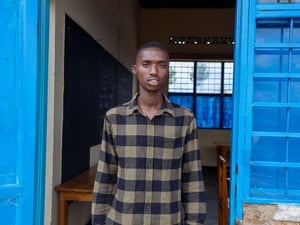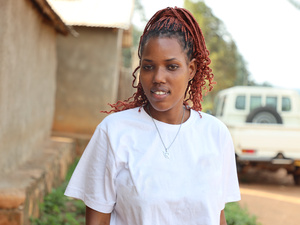Rwandan school bridges language gulf for Burundian students

Rwandan school bridges language gulf for Burundian students
Two years ago, Lydiella Hakizimana knew no more than a few words of English. Today it is her favourite subject.
As the bell rings for the start of the day at Paysannat L School, just outside Mahama refugee camp, she is at her desk ready to begin.
After civil unrest erupted in Burundi in 2015 over disputed elections, Lydiella, her mother and her three sisters joined refugees streaming into neighbouring Rwanda. Today there are more than 50,000 in Mahama, a camp close to the Burundian border.
Keen to regain some stability in her life, Lydiella, 13, looked forward to resuming her education. However, in Rwanda classes are taught in English, not French as in Burundi.
UNHCR, the UN Refugee Agency, and the Rwandan Government devised a solution. Together, they set up a system that enables refugee children to plug into Rwanda’s national curriculum.
“It was the first time I had heard about the sciences and social studies.”
This was in the form of a comprehensive, six-month bridging course, known as the orientation project, which includes English lessons. It is one of many such initiatives supported by UNHCR around the world to boost refugees’ education and help them move into a formal learning environment.
Refugees who largely missed out on an education at home follow the entire course. Others are enrolled in state schools at a suitable level as soon as they are ready. At the 2016 UN Summit for Refugees and Migrants, Rwanda pledged to help include Burundian refugees in its national education system. It is striving to meet that promise.
The bridging course introduced Lydiella to more than another language. It is designed to educate students in other subjects, too. “It was the first time I had heard about the sciences and social studies,” she says. “Orientation is a way of getting used to what other students study here, especially if you are a newcomer.”
Charles Munyaneza, UNHCR’s associate education officer based in Kigali, says: “We realized we needed to integrate refugee students into the national system as they faced serious barriers to coping and adapting.”
“It is a really crucial step towards including refugees in the national education system.”
The bridging project started at Mahama in June 2015 with 2,500 students. Since then, more than 19,000 children have passed through. “It is a really crucial step towards including refugees in the national education system,” says Munyaneza.
Paysannat L is one of several schools in the area with the Paysannat name – with a total student population of almost 20,000 – but it is the only one where refugees and local students learn side-by-side. Jean-Claude Muhyemama, the deputy head, says having a common language has played an important role in integrating the two communities and promoting good relations.
“This project has really helped the Burundian students get to the same level as Rwandan students,” he says. “At the beginning, they knew very little or no English but now they can express themselves well.”
Having adapted to the Rwandan curriculum and reached the last year of primary school, Lydiella enjoys her studies hugely. She hopes one day to spread her love of English to her fellow Burundians. “If one day I return to Burundi, I will teach others English because it is important,” she says. “It is spoken around the whole world and so I think if people learn it, it will help them in their life.”
Jean Harindwa, Lydiella’s English teacher, has been working at the school since it opened in 2015. Himself a Burundian, he says teaching English has helped him with his own mastery of the language. “It was a good thing to start this project,” he says.
“Most of these students fled their country and they didn’t think they would ever learn again.”
See UNHCR's 2017 report on refugee education, Left Behind: Refugee Education in Crisis.










